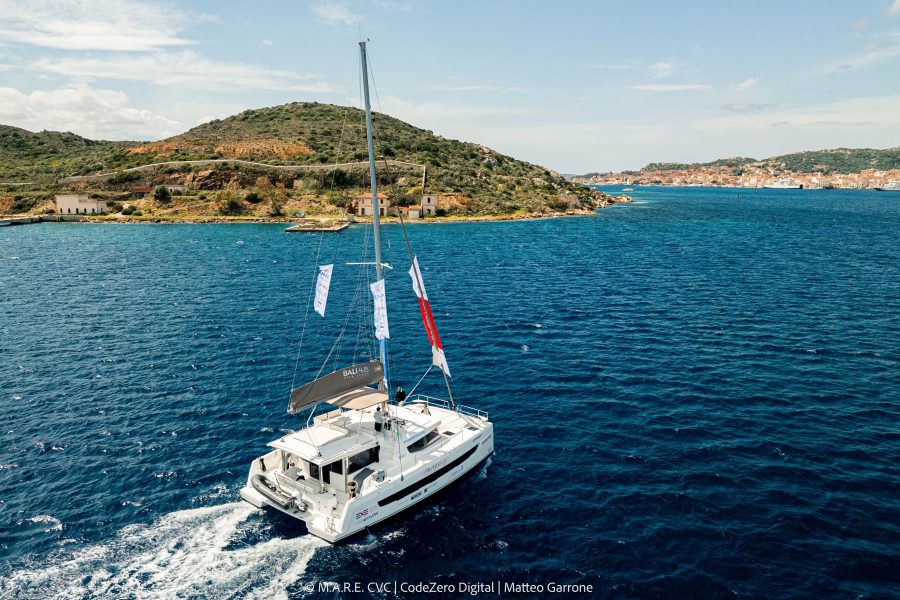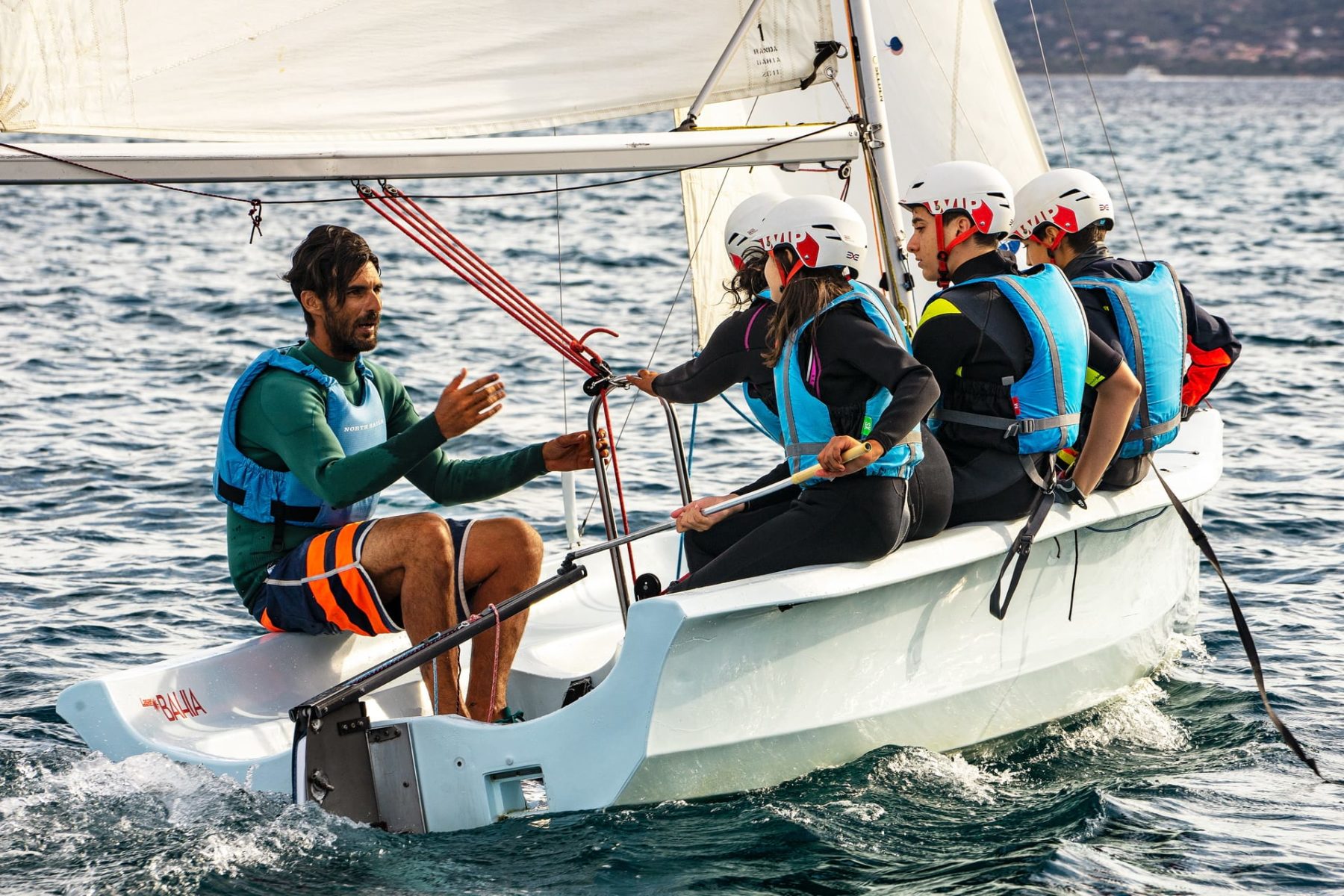M.A.R.E. 2024 expands its boundaries again: route to the Northwest Mediterranean
The CVC Foundation - Centro Velico Caprera ETS, in collaboration with One Ocean Foundation, presents
the third edition of the research and outreach project on the health of the Mediterranean Sea.
It departs April 27 from La Maddalena, where it will return after also stopping in France and Spain.
Long long before the image "environmental sustainability" became part of our daily lexicon and thus since the mid-1960s, at Caprera this expression had a precise meaning and practical application. In 56 years of operation, the school has conveyed seafaring culture and passion for the sea to more than 150 thousand pupils and students. And from this love, the project has grown, developed, adapted to the changing times and today, through the CVC Foundation - Centro Velico Caprera ETS, presents the third edition of the M.A.R.E. project (an acronym for Marine Adventure for Research & Education), a special initiative that combines seafaring practice, scientific research and promotion for the preservation of the Mediterranean Sea, again with the close scientific collaboration of partner One Ocean Foundation.
The One catamaran sailed in 2022 through the entire Tyrrhenian Sea, moving in 2023 to the Adriatic Sea through 6 countries. The rendezvous for 2024 presents a great novelty: it will return to La Maddalena "home of the Foundation, where it all began," which will be the starting and ending point of this adventure that will touch other countries, Italy, France and Spain bordering the Mare Nostrum in 10 stages, reconfirming the international scope of the mission. It sets sail on April 27 from La Maddalena, returning to Sardinia on July 6. After touching the coasts of Italy, France and Spain, docking in Savona, Nice, Marseille, Port-Argelès, Barcelona, Ibiza, Menorca, Ajaccio, Santa Teresa di Gallura and back to La Maddalena.

"Environmental protection has always been in our DNA. It is also to provide the right response to projects like this that our Foundation was established a year ago. M.A.R.E. is a very special idea that aims to monitor the health of the Mediterranean, promoting knowledge and protection of the marine environment. In the first two years," explains Stefano Crosta, president of the CVC Foundation - Centro Velico Caprera ETS, "six universities have come on board. This year's main goal is to host researchers and institutions, such as the Navy, on board the catamaran One for more than two months to Collect and analyze data on chemical pollution of water and marine biodiversity in the Mediterranean Sea, both in fauna and flora, and become a true scientific platform of international reference. In line with the letter "E" of this essential initiative for us: Education. The same message that the sailing school reiterates to all the students who have been attending and living it for more than half a century. For people who have the sea as a passion, this passage becomes indispensable, as well as an excellent means of communication for those who support the project. There is a growing need for a special focus on the mission that the partners intend to develop through their collaboration with the project. The communication focus from the very beginning of this idea has been to publicize the scientific aspect, commitment and community awareness to the protection and knowledge of the sea. Therefore, in the search and selection of partners, sharing this cultural goal was crucial. Each will be physically on board the catamaran and will support us in increasing the visibility of the project as it evolves over the weeks. It is with pride that we can boast of very important partnerships of international caliber. All with their own expertise and excellence. Starting with One Ocean Foundation, Navy, Coast Guard and Autonomous Region of Sardinia. In addition to realities sensitive to the project's issues that have stood by since its inception, such as Yamamay and Toio, joined this year by Shiseido and Deutsche Bank Italia Foundation, Workness Club and certification by ASVIS, Italian Alliance for Sustainable Development.
The numbers of the first two editions tell a good story of the great work done: nearly 3,000 miles sailed and about 200 guests on board. And these studies have become the subject of popularization, scientific articles and even dissertations that leave a tangible and lasting legacy for new generations."
The project is gaining an increasingly international dimension, partly because of the scientific results produced, which represent a "unicum" in the world of research in relation to the Mediterranean Sea.
These are the scientific aims of the 2024 edition of M.A.R.E.:
a) To contribute to the knowledge and conservation of marine biodiversity through environmental DNA, photo identification and bioacoustics analysis.
b) Assess the contamination status of the Mediterranean Sea through ecotoxicology analysis, bacterial community study, isotope analysis and microplastic pollution.
"We are extremely happy to continue our collaboration with the CVC Foundation-Centro Velico Caprera ETS as scientific partners of the M.A.R.E. project, for the third consecutive year. From the very beginning, One Ocean Foundation has strongly believed in this initiative, which represents for us an excellent synthesis of our mission: to promote education and knowledge on marine environmental protection on the one hand, and on the other hand to expand high-impact monitoring and scientific research activities, particularly on the Mediterranean Sea," says Riccardo Bonadeo, President of One Ocean Foundation.The M.A.R.E. project has so far produced relevant results in the field of eco-toxicology, particularly with regard to both the Tyrrhenian and the Adriatic Seas." This is confirmed by Ginevra Boldrocchi, Scientific Coordinator of One Ocean Foundation "Our goal remains to have a baseline dataset of the whole basin. Therefore we are excited to carry out this third edition and to be able to collect samples from the Western Mediterranean area."
"The Navy has always been resolutely committed to preserving the marine environment, demonstrating a growing sensitivity to the environmental issues that characterize the contemporary era," says Captain Paolo Spagnoletta. "This commitment translates into concrete and multidimensional action through the various training and operational campaigns aimed at protecting national and international waters from all forms of pollution. To M.A.R.E.'s mission, the Navy offers its contribution with teams of specialists engaged in monitoring marine environmental parameters, control and protection of marine biodiversity, in support of scientific research initiatives."
Past editions
Year 2022 is the first edition of M.A.R.E. A long tour in the Tyrrhenian Sea starting from La Maddalena, after the circumnavigation of Sardinia we move to Sicily, arriving from the Western to the Eastern part. Then the ascent through the Strait of Messina to Liguria, to Portofino before returning to Porto Palma, for a total of 1,500 miles sailed, in 85 days at sea. One hundred guests boarded the catamaran and participated in a total of 23 events. Ten beaches cleaned of litter over the course of this voyage. Thirty-five water samples were collected for environmental DNA analysis, while 54 were zooplankton samples collected to assess the presence of pollutants. All guests of the ONE catamaran, partners, ambassadors/influencers, actively collaborated with the scientists in the sampling and sighting activities. The considerable amount of information collected comprehensively provided a true and in-depth snapshot of the health of the Tyrrhenian Sea, its species, and its pollution at various depth levels. The robust sampling work, carried out throughout, allowed for in-depth analysis and study in relation to the intended objectives of monitoring marine biodiversity, through molecular analysis and presence of persistent contaminants.
In 2023 we change sides and move to the Adriatic: thanks to the irreplaceable partnership with the Navy, the departure is set in Taranto, in the historic national base. M.A.R.E takes a further leap forward and becomes definitively international. During the navigation it goes up Italy as far as Venice, before changing sides in the Adriatic and going down touching Slovenia, Croatia, Montenegro, Albania and finally Greece in the Aegean Islands to Corfu, where the arrival is set on July 8, after the departure from Puglia had taken place on April 29. Important numbers again for this second edition: 1235 miles sailed, 96 guests on board and as many as 33 sightings. A total of 46 plankton samples were collected, while 20 environmental DNA samples were brought to the laboratories. The scientific results are also outstanding with 4 Universities or Research Institutes involved. Five research projects completed, several articles appeared in scientific journals and even 3 dissertations that had as their subject the data collected on this voyage.







